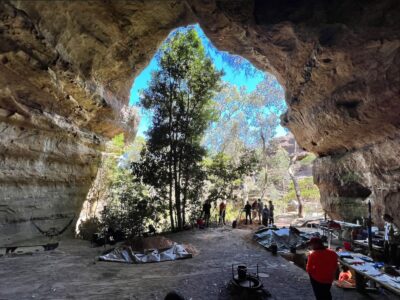
Imagine an iceberg floating in the ocean. Most people picture a tall, pointy chunk of ice with a huge hidden section underwater. While it is true that only 10% of an iceberg sits above the surface of the water, popular portrayals of icebergs are often inaccurate, because any elongated iceberg will float with its long axis parallel to the water’s surface — on its side, compared to the usual pictures we see. Now, because of a viral tweet and an interactive website, more people are learning about this icy reality.

Megan Thompson-Munson, a PhD student at the University of Colorado Boulder studying the interactions between ice sheets and a changing climate, was looking for a way to bridge her newfound pandemic hobby, watercolor painting, and her research. Her research made her well aware that as the climate changes, the melting of glaciers and ice sheets is accelerating and there is an increase in icebergs calving, or breaking off of, ice sheets or glaciers. When coastal glaciers flow, masses of ice calve off into the ocean.
When Thompson-Munson searched online for images of icebergs to inspire her watercolor paintings, they didn’t resemble the icebergs she had seen in her own research. “I found myself looking at a screen of drawings and paintings of icebergs in unstable positions,” she told GlacierHub. “So when I set out to draw my own iceberg, I realized that all of these were wrong and I had to draw it differently.”
After finishing her watercolor, she tweeted it out in late February with a thread of scientific background. This tweet soon went viral, with many glaciologists praising her for finally setting the record straight on how an iceberg actually floats.
Today I channeled my energy into this very unofficial but passionate petition for scientists to start drawing icebergs in their stable orientations. I went to the trouble of painting a stable iceberg with my watercolors, so plz hear me out.
(1/4) pic.twitter.com/rtkCYub38b
— Megan Thompson-Munson (@GlacialMeg) February 19, 2021
A day later, Josh Tauberer, a software developer and civic technologist, created an interactive website where people can draw their own theoretical iceberg and see how it would float in the ocean. “After reading the thread on the tweet, I saw that there is a really simple mathematical explanation for the underlying principle of how an iceberg floats,” he said. “I combined this with my knowledge of scientific computing and made a web app, Iceberger.” Another online simulator, Iceberger Remixed, was created soon after where users can choose preset shapes and see how melting will affect the icebergs.
In Thompson-Munson’s Twitter thread, she included a popular article by Henry Pollack, an emeritus professor of geophysics at the University of Michigan, explaining why icebergs float on their side instead of vertically. The scientific explanation for why an iceberg will float on its side comes from a simple interaction between two forces, gravity and the water’s buoyancy.
“The key thing to understand is the alignment between the force of gravity that pulls the iceberg down at its center of gravity and the buoyancy of the water that pushes up on the iceberg,” explained Tauberer. “If the iceberg isn’t symmetrical, meaning the center point of the iceberg is a little off to the left or right, then the iceberg will rotate until equilibrium between the center of the iceberg’s gravity and the buoyancy force is established.”
While most people don’t have the opportunity to witness huge icebergs floating in the Earth’s polar regions, there are a few other ways people can visualize them at home. “I’ve suggested to people that in addition to the Iceberger website they can also take an ice cube or a cork from a wine bottle and put them in water and see that they’ll float on their side,” Thompson-Munson told GlacierHub.
View this post on Instagram
Megan Thompson-Munson’s artistic tweet and the interactive web apps inspired by it are examples of art’s ability to challenge popular misconceptions of scientific principles. As scientific understanding has become more essential as we face the climate crisis, communication has become more important than ever.
After her tweet went viral, Thompson-Munson connected with other scientists regarding scientific misconceptions beyond iceberg stability. “One of the cool things about this tweet has been that people have reached out with misconceptions in their own scientific fields and have suggested that I paint them, too. While I might not have the time to do this myself, I do think it’s important that these conversations have started.”



